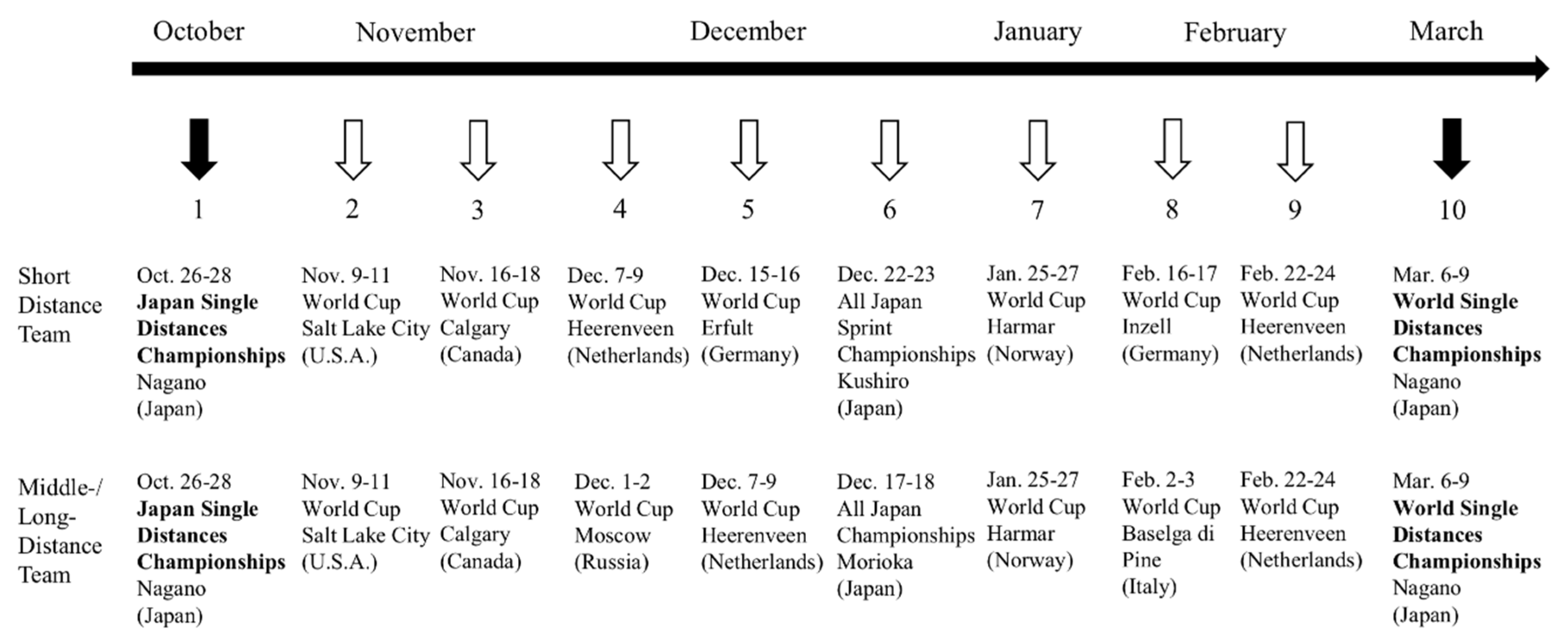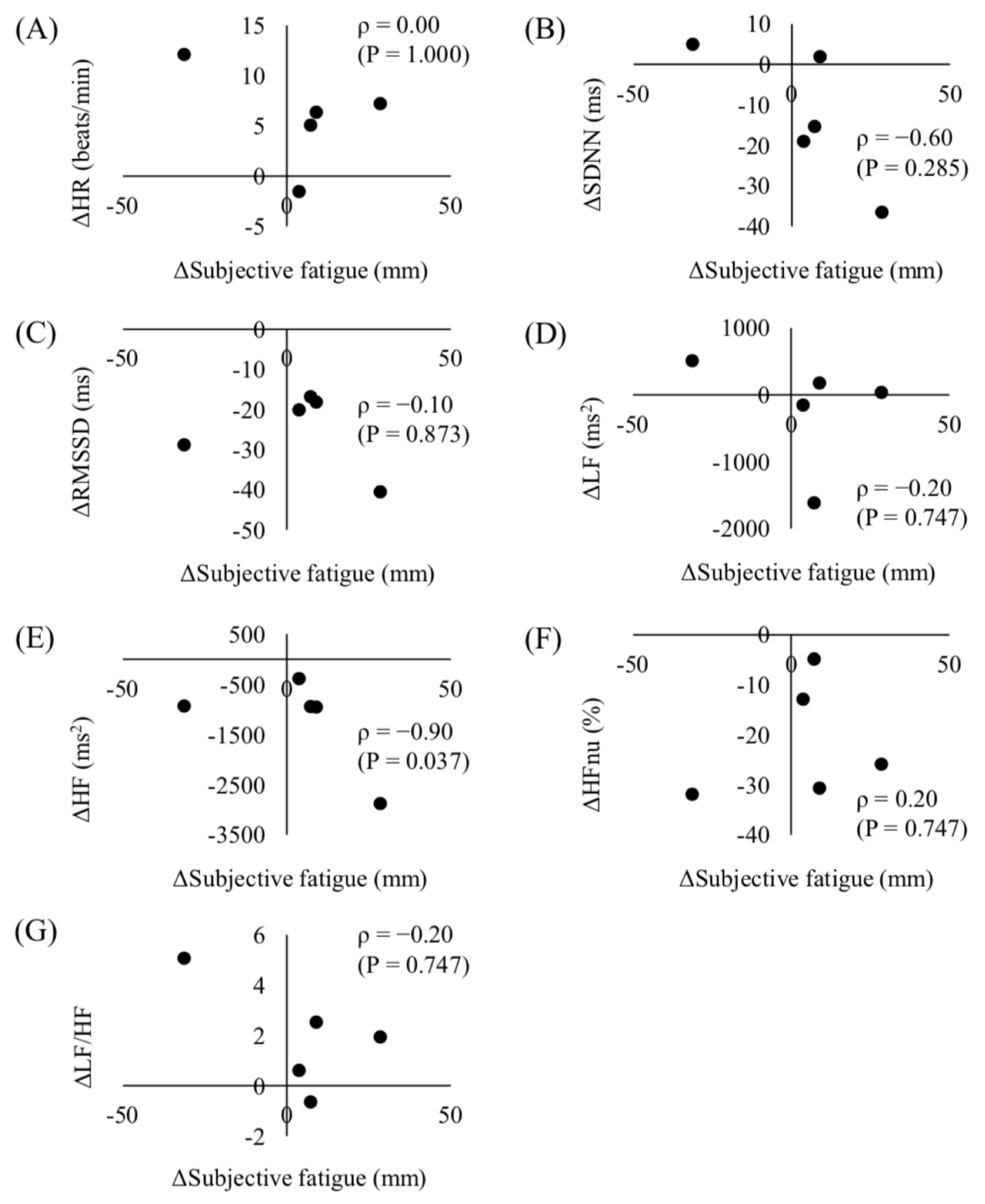Comparison of Morning Heart Rate Variability at the Beginning and End of a Competition Season in Elite Speed Skaters
Abstract
:1. Introduction
2. Materials and Methods
2.1. Subjects
2.2. Procedures
2.3. Measurements
2.3.1. Subjective Fatigue
2.3.2. HRV
2.3.3. Race Performance
2.4. Statistical Analysis
3. Results
3.1. Subjective Fatigue
3.2. HRV
3.3. Correlation between Changes in Subjective Fatigue and Changes in HRV
3.4. Race Performance
4. Discussion
Author Contributions
Funding
Conflicts of Interest
References
- Muehlbauer, T.; Schindler, C.; Panzer, S. Pacing and sprint performance in speed skating during a competitive season. Int. J. Sports Physiol. Perform. 2010, 5, 165–176. [Google Scholar] [CrossRef] [Green Version]
- Silva, M.G.; Paiva, T.; Silva, H.H. The elite athlete as a special risk traveler and the jet lag’s effect: Lessons learned from the past and how to be prepared for the next Olympic Games 2020 Tokyo. J. Sports Med. Phys. Fit. 2019, 59, 1420–1429. [Google Scholar] [CrossRef] [PubMed]
- Fowler, P.M.; Murray, A.; Farooq, A.; Lumley, N.; Taylor, L. Subjective and objective responses to two Rugby Sevens World Series competitions. J. Strength Cond. Res. 2019, 33, 1043–1055. [Google Scholar] [CrossRef] [PubMed]
- Task Force of the European Society of Cardiology and the North American Society of Pacing and Electrophysiology. Heart rate variability: Standards of measurement, physiological interpretation and clinical use. Circulation 1996, 93, 1043–1065. [Google Scholar] [CrossRef] [Green Version]
- Buchheit, M. Monitoring training status with HR measures: Do all roads lead to Rome? Front. Physiol. 2014, 5, 73. [Google Scholar] [CrossRef] [PubMed] [Green Version]
- Crowcroft, S.; McCleave, E.; Slattery, K.; Coutts, A.J. Assessing the measurement sensitivity and diagnostic characteristics of athlete-monitoring tools in national swimmers. Int. J. Sports Physiol. Perform. 2017, 12, S2-95–S2-100. [Google Scholar] [CrossRef] [PubMed] [Green Version]
- Flatt, A.A.; Esco, M.R.; Nakamura, F.Y. Individual heart rate variability responses to preseason training in high level female soccer players. J. Strength Cond. Res. 2017, 31, 531–538. [Google Scholar] [CrossRef]
- Uusitalo, A.L.; Uusitalo, A.J.; Rusko, H.K. Endurance training, overtraining and baroreflex sensitivity in female athletes. Clin. Physiol. 1998, 18, 510–520. [Google Scholar] [CrossRef] [Green Version]
- Flatt, A.A.; Hornikel, B.; Esco, M.R. Heart rate variability and psychometric responses to overload and tapering in collegiate sprint-swimmers. J. Sci. Med. Sport 2017, 20, 606–610. [Google Scholar] [CrossRef]
- Flatt, A.A.; Esco, M.R.; Nakamura, F.Y.; Plews, D.J. Interpreting daily heart rate variability changes in collegiate female soccer players. J. Sports Med. Phys. Fit. 2017, 57, 907–915. [Google Scholar]
- Atlaoui, D.; Pichot, V.; Lacoste, L.; Barale, F.; Lacour, J.R.; Chatard, J.C. Heart rate variability, training variation and performance in elite swimmers. Int. J. Sports Med. 2007, 28, 394–400. [Google Scholar] [CrossRef] [PubMed]
- Iizuka, T.; Ohiwa, N.; Atomi, T.; Shimizu, M.; Atomi, Y. Morning heart rate variability as an indication of fatigue status in badminton players during a training camp. Sports 2020, 8, 147. [Google Scholar] [CrossRef]
- Naranjo, J.; De la Cruz, B.; Sarabia, E.; De Hoyo, M.; Dominguez-Cobo, S. Heart rate variability: A follow-up in elite soccer players throughout the season. Int. J. Sports Med. 2015, 36, 881–886. [Google Scholar] [CrossRef] [PubMed]
- Kon, M.; Iizuka, T.; Maegawa, T.; Hashimoto, E.; Yuda, J.; Aoyanagi, T.; Akimoto, T.; Takahashi, H. Salivary secretory immunoglobulin a response of elite speed skaters during a competition period. J. Strength Cond. Res. 2010, 24, 2249–2254. [Google Scholar] [CrossRef] [PubMed]
- Gamelin, F.X.; Berthoin, S.; Bosquet, L. Validity of the polar S810 heart rate monitor to measure R-R intervals at rest. Med. Sci. Sports Exerc. 2006, 38, 887–893. [Google Scholar] [CrossRef] [Green Version]
- Tarvainen, M.P.; Niskanen, J.P.; Lipponen, J.A.; Ranta-Aho, P.O.; Karjalainen, P.A. Kubios HRV—Heart rate variability analysis software. Comput. Meth. Prog. Biomed. 2014, 113, 210–220. [Google Scholar] [CrossRef]
- Pichot, V.; Roche, F.; Gaspoz, J.M.; Enjolras, F.; Antoniadis, A.; Minini, P.; Costes, F.; Busso, T.; Lacour, J.R.; Barthélémy, J.C. Relation between heart rate variability and training load in middle-distance runners. Med. Sci. Sports Exerc. 2000, 32, 1729–1736. [Google Scholar] [CrossRef] [Green Version]
- Fritz, C.O.; Morris, P.E.; Richler, J.J. Effect size estimates: Current use, calculations, and interpretation. J. Exp. Psychol. Gen. 2012, 141, 2–18. [Google Scholar] [CrossRef] [Green Version]
- Hopkins, W.G.; Marshall, S.W.; Batterham, A.M.; Hanin, J. Progressive statistics for studies in sports medicine and exercise science. Med. Sci. Sports Exerc. 2009, 41, 3–13. [Google Scholar] [CrossRef] [Green Version]
- Iellamo, F.; Legramante, J.M.; Pigozzi, F.; Spataro, A.; Norbiato, G.; Lucini, D.; Pagani, M. Conversion from vagal to sympathetic predominance with strenuous training in high-performance world class athletes. Circulation 2002, 105, 2719–2724. [Google Scholar] [CrossRef] [Green Version]
- Schmitt, L.; Regnard, J.; Millet, G.P. Monitoring fatigue status with HRV measures in elite athletes: An avenue beyond RMSSD? Front. Physiol. 2015, 6, 343. [Google Scholar] [CrossRef] [PubMed] [Green Version]
- Rabbani, A.; Clemente, F.M.; Kargarfard, M.; Chamari, K. Match fatigue time-course assessment over four days: Usefulness of the Hooper index and heart rate variability in professional soccer players. Front. Physiol. 2019, 10, 109. [Google Scholar] [CrossRef] [PubMed]
- Garet, M.; Tournaire, N.; Roche, F.; Laurent, R.; Lacour, J.R.; Barthélémy, J.C.; Pichot, V. Individual interdependence between nocturnal ANS activity and performance in swimmers. Med. Sci. Sports Exerc. 2004, 36, 2112–2118. [Google Scholar] [CrossRef] [PubMed]
- Kiviniemi, A.M.; Hautala, A.J.; Kinnunen, H.; Tulppo, M.P. Endurance training guided individually by daily heart rate variability measurements. Eur. J. Appl. Physiol. 2007, 101, 743–751. [Google Scholar] [CrossRef] [PubMed]
- Pichot, V.; Busso, T.; Roche, F.; Garet, M.; Costes, F.; Duverney, D.; Lacour, J.R.; Barthélémy, J.C. Autonomic adaptations to intensive and overload training periods: A laboratory study. Med. Sci. Sports Exerc. 2002, 34, 1660–1666. [Google Scholar] [CrossRef]
- Morales, J.; Alamo, J.M.; Garcia-Massó, X.; Buscà, B.; López, J.L.; Serra-Añó, P.; González, L.M. Use of heart rate variability in monitoring stress and recovery in judo athletes. J. Strength Cond. Res. 2014, 28, 1896–1905. [Google Scholar] [CrossRef]
- Botek, M.; McKune, A.J.; Krejci, J.; Stejskal, P.; Gaba, A. Change in performance in response to training load adjustment based on autonomic activity. Int. J. Sports Med. 2014, 35, 482–488. [Google Scholar] [CrossRef]
- Earnest, C.P.; Jurca, R.; Church, T.S.; Chicharro, J.L.; Hoyos, J.; Lucia, A. Relation between physical exertion and heart rate variability characteristics in professional cyclists during the Tour of Spain. Br. J. Sports Med. 2004, 38, 568–575. [Google Scholar] [CrossRef] [Green Version]



| Competition | 4 Days Pre-Race | 3 Days Pre-Race | 2 Days Pre-Race | 1 Day Pre-Race | |
|---|---|---|---|---|---|
| Subjective fatigue (mm) | JSDC | 50.0 (41.0–50.0) | 50.0 (50.0–50.0) | 33.0 (23.0–49.0) | 39.0 (1.0–50.0) |
| WSDC | 50.0 (22.0–67.0) | 30.0 (15.0–50.0) | 50.0 (38.0–50.0) | 50.0 (38.0–50.0) |
| JSDC | WSDC | p-Value | Effect Size | |
|---|---|---|---|---|
| Subjective fatigue (mm) | 46.3 (25.0–47.0) | 50.0 (32.0–53.5) | 0.500 | 0.30 |
| Index | Competition | 4 Days Pre-Race | 3 Days Pre-Race | 2 Days Pre-Race | 1 Day Pre-Race |
|---|---|---|---|---|---|
| HR (beats/min) | JSDC | 54.5 (52.4–55.5) | 51.1 (49.2–54.2) | 51.6 (50.1–52.1) | 52.4 (51.8–55.6) |
| WSDC | 55.1 (55.1–57.7) | 56.0 (50.3–60.8) | 61.8 (55.2–63.2) | 59.7 (57.9–64.9) | |
| SDNN (ms) | JSDC | 67.0 (66.7–82.6) | 94.9 (62.4–111.5) | 63.8 (63.1–115.8) | 79.6 (57.7–109.1) |
| WSDC | 88.2 (83.5–97.0) | 76.7 (40.0–79.0) | 73.0 (55.1–75.3) | 64.3 (58.4–73.7) | |
| RMSSD (ms) | JSDC | 48.7 (48.5–51.5) | 74.7 (73.4–84.9) | 67.4 (58.5–97.0) | 54.7 (40.7–75.8) |
| WSDC | 60.5 (45.6–83.0) | 38.2 (27.0–45.5) | 36.8 (36.8–46.4) | 33.9 (27.5–40.6) | |
| LF (ms2) | JSDC | 1312 (762–3152) | 1690 (1016–2872) | 2735 (1443–3178) | 1706 (1089–2789) |
| WSDC | 2328 (2088–2490) | 866 (611–1491) | 1473 (1411–3021) | 1101 (1079–1378) | |
| HF (ms2) | JSDC | 831 (758–1034) | 2048 (1509–3367) | 1931 (1015–3176) | 951 (426–1908) |
| WSDC | 958 (582–2311) | 435 (236–499) | 424 (315–828) | 268 (172–272) | |
| HFnu (%) | JSDC | 42.5 (38.8–45.3) | 53.9 (53.3–54.3) | 47.0 (41.3–58.8) | 56.9 (35.8–63.7) |
| WSDC | 31.4 (17.2–49.8) | 27.9 (27.4–28.8) | 16.8 (14.3–37.8) | 19.5 (16.5–29.5) | |
| LF/HF | JSDC | 1.35 (1.21–1.58) | 0.85 (0.84–0.87) | 1.13 (0.70–1.42) | 0.76 (0.57–1.79) |
| WSDC | 2.18 (1.01–4.81) | 2.59 (2.47–2.65) | 4.95 (1.65–6.00) | 4.12 (2.38–5.07) |
| Index | JSDC | WSDC | p-Value | Effect Size |
|---|---|---|---|---|
| HR (beats/min) | 52.6 (51.8–52.8) | 60.0 (54.6–62.5) | 0.080 | 0.78 |
| SDNN (ms) | 76.1 (75.5–79.1) | 71.1 (63.7–81.0) | 0.225 | 0.54 |
| RMSSD (ms) | 61.0 (60.3–62.2) | 42.1 (38.0–42.1) | 0.043 | 0.91 |
| LF (ms2) | 1326 (1226–2912) | 1504 (1297–1736) | 0.893 | 0.06 |
| HF (ms2) | 1393 (1339–1450) | 443 (400–1064) | 0.043 | 0.91 |
| HFnu (%) | 53.2 (49.4–56.2) | 25.5 (21.8–30.9) | 0.043 | 0.91 |
| LF/HF | 1.00 (0.81–1.16) | 3.35 (2.75–4.26) | 0.138 | 0.66 |
Publisher’s Note: MDPI stays neutral with regard to jurisdictional claims in published maps and institutional affiliations. |
© 2020 by the authors. Licensee MDPI, Basel, Switzerland. This article is an open access article distributed under the terms and conditions of the Creative Commons Attribution (CC BY) license (http://creativecommons.org/licenses/by/4.0/).
Share and Cite
Iizuka, T.; Kon, M.; Maegawa, T.; Yuda, J.; Aoyanagi, T.; Takahashi, H.; Atomi, T.; Shimizu, M.; Atomi, Y. Comparison of Morning Heart Rate Variability at the Beginning and End of a Competition Season in Elite Speed Skaters. Sports 2020, 8, 164. https://0-doi-org.brum.beds.ac.uk/10.3390/sports8120164
Iizuka T, Kon M, Maegawa T, Yuda J, Aoyanagi T, Takahashi H, Atomi T, Shimizu M, Atomi Y. Comparison of Morning Heart Rate Variability at the Beginning and End of a Competition Season in Elite Speed Skaters. Sports. 2020; 8(12):164. https://0-doi-org.brum.beds.ac.uk/10.3390/sports8120164
Chicago/Turabian StyleIizuka, Taro, Michihiro Kon, Taketeru Maegawa, Jun Yuda, Toru Aoyanagi, Hideyuki Takahashi, Tomoaki Atomi, Miho Shimizu, and Yoriko Atomi. 2020. "Comparison of Morning Heart Rate Variability at the Beginning and End of a Competition Season in Elite Speed Skaters" Sports 8, no. 12: 164. https://0-doi-org.brum.beds.ac.uk/10.3390/sports8120164






